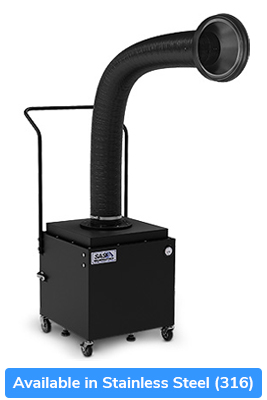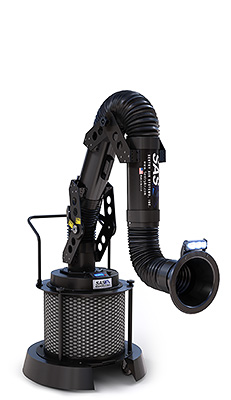
Sentry Air- Welding Fume Extractors
For Quotes, simply add desired products to your quote request with the Add to Quote button. You can view your full request at any time by selecting the View Current Quote Request button on the sidebar. If you need assistance please call us at (888) 240-7247 or email sales@ifindustrial.com
Senty Air Systems Improves Air Quality With High Efficiency Filtration & Versatile Solutions
Welding Fume Extractors are designed to be utilized as an engineering safety control to protect users from the occupational hazards presented with various welding applications. Given that the vast majority of the respirable particles in the airstream are under .4 microns in size, a filtered ventilation system that can filter down to that level is what is required to ensure the safety and health of the welder.
When choosing an adequate ventilation system, it is important to make sure that you are aware of all of the elements that could vary the efficiency of the filtration of welding fumes. The particular welding application is usually the number one variable that helps decipher what is recommended, but additional configurations such as HEPA or ASHRAE filters, cleanable media, multi-operators, or portability are dependent of different elements that are best discussed with a trained specialist.
What is a Welding Fume Extractor?
When welding with metals in welding applications that generate toxic gases, a welding fume extractor is required to improve indoor air quality by removing welding fume particulate, or hazardous metal fumes. As a purification device, a welding fume extractor is designed to reduce the risk of serious respiratory issues.
At Sentry Air Systems, we offer a broad range of welding fume extraction systems as an integral part of the hierarchy of controls for managing fume and serve as the safety control from hazardous particles left behind in welding applications. Depending on the type of welding application, location, any fillers or base metals used, and a few other variables, it is imperative to help identify the best fume extraction system required to achieve safe, clean air in your industrial environment.
Welding Fume Extractor Benefits
Welding fume extractors offer several key advantages when weighing your options to protect your respiratory breathing zone:
- A safer, healthier, breathing zone
- Reduces harmful toxic gases and welding smoke
- Supports higher productivity as a result of a healthier work environment
- Minimizes air pollution
Welding Fume Health Effects
Short-term health effects
- Exposure to metal fumes may cause metal fume fever. Onset of symptoms may occur 4-12 hrs after exposure and include chills, thirst, fever, muscle ache, chest soreness, coughing, wheezing, fatigue, and nausea.
- Welding smoke can irritate the eyes, nose, chest, and respiratory tract. It can cause coughing, wheezing, bronchitis, pulmonary edema, and pneumonitis. Gastrointestinal effects have also been known to occur.
- Some components of welding fumes, such as cadmium, can be fatal in a short time. Additionally, some gases that are deadly at high levels, like nitrogen oxides and ozone, can form during welding. Phosgene is another deadly gas that has been known to form.
Long-term health effects
- Welders face an increased risk of lung cancer, cancer of the larynx and urinary tract.
- Chronic respiratory problems including bronchitis, asthma, pneumonia, emphysema, pneumoconiosis, decreased lung capacity, silicosis, and siderosis
- Other problems related to welding include: heart disease, skin diseases, gastritis, gastrodduodenitis, kidney damage, and ulcers
- Reproductive problems (delayed contraception and increased miscarriages) have also been discovered among welders, especially those working with stainless steel
Welding Fume Health Hazards
Welding fume hazards are a direct correlation of what can be inhaled through the welding process. Most of the hazardous substances are very fine, respirable particles of different types of metals, including:
| Chromium | Nickel | Arsenic |
| Asbestos | Manganese | Silica |
| Beryllium | Cadmium | Cobalt |
| Copper | Lead | Zinc |
Manganese containing fumes is one of the biggest risks encountered in welding smoke. Inhalation of the metal can cause serious damage to the brain and nervous system. Manganese fumes can result in the onset of Parkinson’s disease, a crippling disorder that affects movement and balance. It also causes “manganism,” which is closely related to Parkinson’s as it makes it difficult to move properly.
Iron oxide can also be contained in the welding fumes, which is very irritating to the respiratory system. There is also cadmium which is used to coat the metals, which can cause lung disease, emphysema, and kidney failure. Other harmful substances include lead oxides and asbestos.
Welding Fume Fever
Welding fume exposure can lead to a wide variety of negative health symptoms, which include, but are not limited to, harm or irritation to the lungs, heart, kidneys and nervous system. These health effects may be both short- and long term.
However, one of the most common health symptoms is Welding Fume Fever, also known as metal fume fever, brass founders’ ague, brass shakes, welding shivers, Monday morning fever, and/or the zinc shakes.
Metal fume fever is caused by inhaling certain metals during or after the process of welding, either as particulates or more commonly, fumes. Exposure of welding fumes typically form through the actual welding process, due to the heating of galvanized metals, alloys, and combustible compounds.
The signs of welding fume fever often relate to the flu, or resemble flu-like symptoms. Common ailments reported are having a fever, nausea, headaches (minor and severe), muscle aches, chest pain, and in some cases pneumonia (Flu-like symptoms normally disappear within 24 to 48 hours. Full recovery often requires one to three weeks). In the most severe cases of metal fume fever, patients reported a burning sensation in the body, lack of urine output, convulsive behaviour, high blood pressure, severe vomiting, and bloody diarrhea.
This information is provided as a customer service and should be independently verified.
Applications
- MIG (Metal Inert Gas) Welding
- GMAW (Gas Metal Arc Welding)
- Arc Welding
- SMAW (Shielded Metal Arc Welding)
- TIG (Tungsten Inert Gas) Welding
- GTAW (Gas Tungsten Arc Welding)
- FCAW (Flux-Cored Arc Welding)
- Maintenance Welding
- Production Welding
- Clean Room Welding
- Stick Welding
- Stainless Steel Tank Welding
- Rapid Location Welding
Brochure (Specs)
Quick Compare

Maintenance
|

Mid Duty
|

Heavy Duty
|

Rugged Air
|
|
|---|---|---|---|---|
| Cabinet Dimensions: | 15.5"L x 13"W x 16.5"H | 22.5"L x 20"W x 19.5"H | 30” D x 30” W x 42.5” H | - 30" diameter - 27 " height, w/ plenum |
| CFM: | Up to 350 CFM |
400 Series: Up to 700 CFM 450 Series: Up to 950 CFM |
500 Series: Up to 869 CFM |
Up to 530 CFM |
| Weight: | Approx. 40 lbs. | 50 lbs. to 100 lbs. | Approx. 225lbs w/out Filters Approx. 317lbs w/ Filters |
Approx. 100 lbs. |
| Electrical | 115/1/60, .2 amps 220/1/50, .75 amps |
115/1/60, 2.5 amps 220/1/50, 1.5 amps |
500: 115/1/60, 5.2 amps 220/1/50, 1.5 amps |
115/1/60, 2 amps 220/1/50, .75 amps |
| Sound Level | 61 to 66 dba (Blower Speed: Low to High) | 60 dba @ 3 ft. | 72 dba @ 3 ft. from hood inlet | Approximately 74 dba (High), 48 dba on (low). 3’ from inlet |

